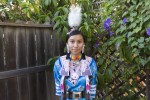Nikita Bichitty launches into the powwow arena, her steps aligning with the rhythmic drumming and spirited chants, woven fabric flowing from her outstretched arms.
Bichitty, now a third-year anthropology student, has traded in her SoCal jeans and T-shirts for colorful Navajo dresses since she was in elementary school. She said she spends nearly half an hour outfitting herself in her tribal attire to participate in Fancy Shawl, a traditional Navajo powwow dance she performs every weekend.
“The shawl is used for spinning, and it makes the dance a lot more graceful and flowing,” Bichitty said.
Bichitty’s Fancy Shawl attire is one piece that will be featured at the UCLA American Indian Student Association’s fashion show Friday at the James West Alumni Center. The event is part of Native Heritage Week, an annual event aimed at recognizing the heritage of students with Native American roots. In addition to Navajo clothing, the fashion show will feature articles of clothing from the Lakota, Cahuilla Cupeño and Asian Pacific Islanders, Bichitty said.
Students and their family members will model the fashion, a combination of family heirlooms, handmade pieces and regalia from local Native American artisans from Los Angeles and San Diego tribes, Bichitty said.
Bichitty, who was born and raised on a Navajo reservation near the Four Corners, said Native Heritage Week and the fashion show help illustrate how different traditional aspects of Native American culture – such as clothing – have translated into modern American society.
“With Native Heritage Week, we’re trying to focus on identity,” Bichitty said. “There’s the cultural aspect of it, which is trying to keep all your cultural knowledge and practices intact, but at the same time trying to succeed in the modern world.”
Bichitty said sharing Native American customs is important given UCLA’s large Native American student population compared to other UC’s. However, media depictions and stereotyping have been working against the widespread understanding and acceptance of Native American culture and fashion, Bichitty said.
“A lot of people just think of the old Western cowboy-Indian thing, where it’s just a guy in a loincloth,” Bichitty said. “But there are really so many different images and versions of Native American people.”
Second-year economics student Minda Streamer’s younger cousin will wear a ribbon skirt representing Streamer’s tribe, the Los Coyotes Band of Cahuilla and Cupeño.
Streamer said she thinks the media typically poses Native Americans not as people, but as cartoons, like the NFL’s Washington Redskins mascot.
Native American stereotypes have also manifested in culturally incorrect Halloween costumes, Streamer said. This year, she said she saw three people dressed as Native Americans in feathers and buckskins.
“I was just really taken aback, like really, you couldn’t find any other costume?” Streamer said. “I hope the fashion show is a way to show that we don’t dress like that. We don’t really look like that.”
American Indian Studies graduate student Damien Montaño, who will be emceeing the fashion show, said he is aware of negative connotations attached to Native American identity. Montaño, who shares heritage with the Yoeme and Purépecha people, will read short blurbs about the history behind each piece of regalia at the event.
“(People) think we’re alcoholics or addicts or that we all benefit from casinos or that we somehow get handouts from the government,” Montaño said. “There’s this idea that Native people are somehow on top of society, but it really doesn’t play out that way.”
Montaño said the fashion show will at least chip away at some of the stereotypical images by demonstrating what Native Americans wear, why they wear it and who can wear it.
“If you show you’re a good person in the tribe, an elder might give you something, like an eagle feather or a headdress,” Montaño said. “Not just anybody wore them; every feather is earned.”
In contemporary fashion, American Indian Studies Department academic adviser and member of the Sicangu Oglala Lakota tribe Clementine Bordeaux said she has seen popular clothing stores like Urban Outfitters putting out generic tribal-print and feathered pieces that do not reflect true Native American culture.
“It’s really asking yourself why you want to wear (Native American-inspired clothing),” Bordeaux said. “If you do feel a connection, maybe instead go to a powwow gathering and buy a shirt or jewelry from one of the Native artists themselves.”
Bordeaux said she feels society is currently at a place where people are at least making an effort to have a conversation about cultural appropriation.
“BuzzFeed just did a series of about three videos where they had Native people come in and talk about Halloween costumes,” Bordeaux said. “I think we’re on a positive upswing right now.”
Montaño said he hopes the fashion show will paint a humanizing picture of Native people by displaying clothing that shows off the personalities of each distinct tribe. However, he said he acknowledges there are still significant obstacles to conquer before there is truly a higher consciousness of Native American cultures.
“People have been making the argument against appropriation for a long time, but people’s voices have not been heard,” Montaño said. “The fashion show is one of those ways we can take steps to improve.”
